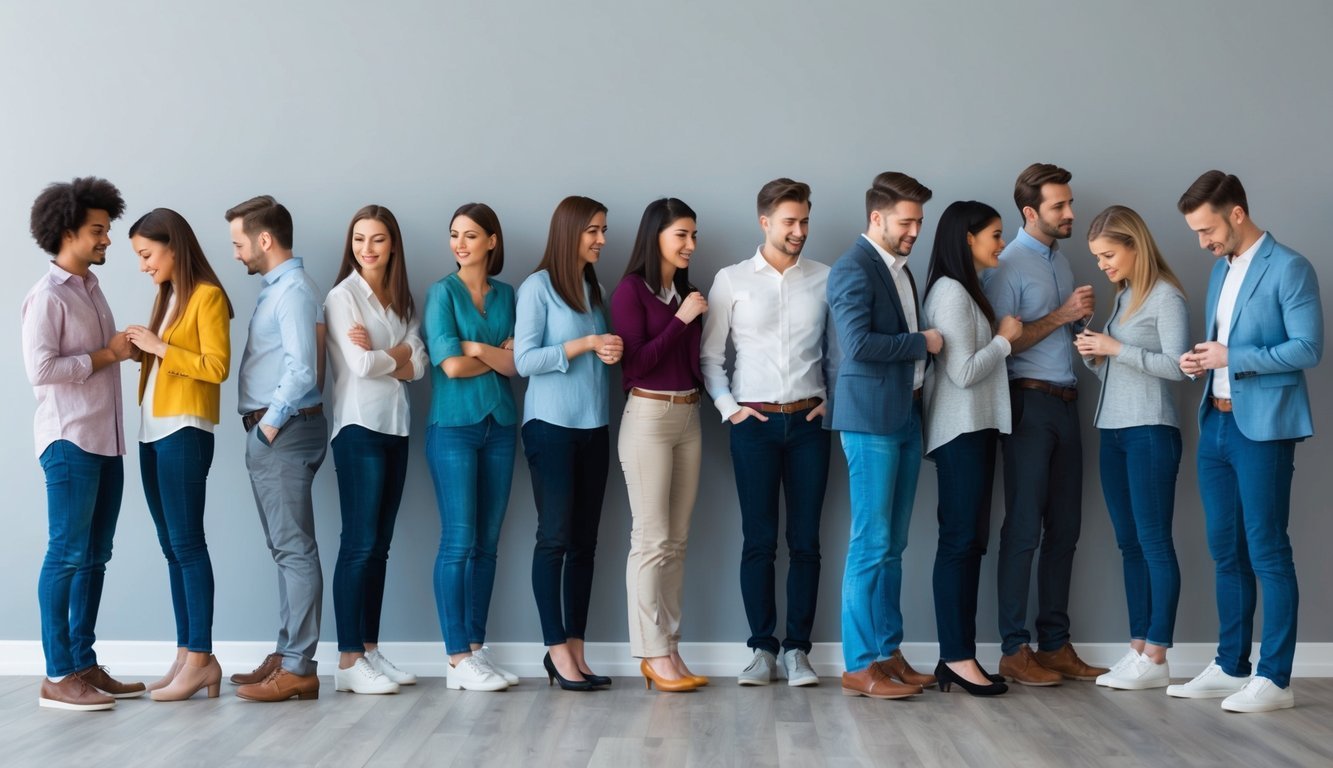PsychNewsDaily Publishers
100 Summit Drive
Burlington, MA, 01803
Telephone: (320) 349-2484
PsychNewsDaily Publishers
100 Summit Drive
Burlington, MA, 01803
Telephone: (320) 349-2484
Singlehood is increasingly accepted as a valid lifestyle choice, influenced by personal freedom, changing family dynamics, and evolving societal views on relationships and independence.

Singlehood is becoming more common in today’s society. This section looks at the rise of one-person households, societal views on singleness, and the influence of family changes on modern values.
One-person households are increasing in many countries. This change often reflects personal choice or lifestyle preferences. More people, especially single women, are choosing to live alone rather than marry.
Living alone allows individuals to focus on personal growth, careers, and hobbies. Many feel that single life offers freedom and independence. Yet, this shift can also lead to feelings of loneliness or marginalization.
A significant factor is the rising number of young adults prioritizing education and careers. They often postpone marriage or romantic relationships. This trend shows a change in traditional views about family and commitments.
Societal views on singleness have evolved over time. In the past, being single may have carried a negative stigma. Today, more people accept being single as a valid lifestyle choice.
Single women are increasingly viewed positively. Many celebrate their independence and accomplishments. However, there are still lingering stereotypes and stigmatization around singlehood. Some may perceive singles as lacking social skills or not being capable of maintaining relationships.
Media representation of single life has also shifted. Shows and movies now highlight the experiences of single characters. This change helps normalize singlehood and reduces feelings of isolation.
Family structures are changing rapidly in modern society. Traditional values surrounding marriage and family are being challenged. Many view marriage as one of many options rather than a necessity.
Families today may prioritize emotional support over marriage. This shift influences younger generations. They often see singlehood as an opportunity for self-discovery and personal happiness.
Additionally, family dynamics now include single-parent households and blended families. Modern values emphasize individual choice and the importance of personal fulfillment. This evolution shapes how society perceives single individuals and their relationships.

Many people struggle with flirting due to various psychological factors. Their mental health influences their ability to engage in dating. Communication barriers can also prevent meaningful connections, leading to involuntary singlehood.
Mental health plays a vital role in romance and dating. Individuals with anxiety or depression may find it hard to approach others. They might worry about how they will be perceived, leading to avoidance of social situations.
Low self-esteem can make flirting feel daunting. If someone feels unworthy of love, they may not even try. This fear can create a cycle of loneliness and missed opportunities.
Education can help people recognize and address these challenges. Understanding mental health can empower individuals to face their fears. Working on mental well-being can lead to healthier relationships and openness to commitment.
Many people face communication barriers when trying to flirt. Misunderstandings can arise, causing awkward moments. This can be particularly challenging for those with different gender identities. Each person brings their own style and expectations to dating.
Non-verbal cues play an essential role in flirting. Many lack confidence in reading these signals. This leads to further hesitation in starting conversations.
Improving communication skills requires practice. Taking classes or engaging in social activities can help. Building these skills allows individuals to express themselves better and strengthen their chances of forming connections.

Cultural norms play a significant role in how people approach relationships and courtship. Understanding these influences can provide insights into behaviors like flirting and the reasons for singlehood.
In many cultures, arranged marriage is common. Families often play a key role in selecting partners based on factors like social status, family ties, and economic stability. This practice emphasizes kinship and familial approval over individual preferences.
In contrast, cultures that value freedom of choice allow individuals more autonomy in selecting their partners. Here, personal attraction and mutual interests guide decisions. This shift can lead to a greater focus on effective flirting skills since individuals must express interest in their chosen partners.
Gender roles significantly shape courtship behaviors. In some cultures, traditional views dictate that men should initiate courtship. This leads to expectations about how men and women should interact. For instance, women may feel pressure to be passive, while men must demonstrate confidence.
Stereotypes about these roles can hinder effective interaction. For example, a man may struggle to flirt if he feels he must conform to rigid expectations. In cultures like India, where gender roles are strong, these dynamics can make flirting even more complex, often influencing the length and nature of singlehood.

Singlehood looks different at various stages of life. How individuals embrace or navigate their single life can greatly affect their experiences and choices.
Single motherhood is a unique journey filled with both challenges and rewards. Many women find themselves raising children alone due to various reasons, such as divorce or choosing not to marry.
These single moms often prioritize their children above all else. They might not have as much time for dating, yet they embrace this phase by cultivating strong bonds with their kids.
Support systems, such as family and friends, are crucial. They help in managing daily life and provide emotional support. Additionally, many single mothers connect with other single moms, creating a community for shared experiences.
As unmarried women navigate single life in adulthood, they face different situations. Many feel societal pressure to settle down, which can lead to feelings of loneliness.
However, single women often enjoy the freedom to explore their interests and careers. They can focus on personal growth and develop strong friendships without the distractions of a relationship.
Developing flirting skills can be important for those considering dating. Learning these skills might impact their ability to connect with potential partners. Understanding one’s needs and desires is key in this stage of singlehood.

Understanding sexuality and identity is crucial for personal empowerment, especially for those navigating singlehood. The way individuals perceive and express their sexual identities can significantly impact their dating experiences and self-confidence.
Feminism plays an essential role in how individuals view their identities and relationships. It encourages women to embrace their singlehood as a valid choice rather than a societal failure.
Key Ideas:
Through embracing feminist ideals, individuals can redefine their views on relationships and personal fulfillment.
Sexual health is key for anyone, particularly for those who are single. It refers not just to physical health but also to emotional well-being. Casual sex can be empowering if approached safely and consensually.
Important Points:
For many individuals, exploring sexuality fosters confidence and clarity regarding their identities. This journey can enhance their empowerment, allowing them to approach relationships on their own terms.

New single women are navigating a landscape shaped by changing cultural attitudes. As modern values evolve, these changes challenge traditional norms regarding singlehood. Understanding how popular culture reflects these realities can empower women and combat stigmatization.
In recent years, popular culture has started to embrace the image of the empowered single woman. Characters in movies and television often celebrate independence and self-discovery. These representations show that being single is not a negative state but rather an opportunity for personal growth.
Media portrayals of single women now highlight diverse experiences and lifestyles. This shift helps normalize singlehood and break down stigmas. The message is clear: being single is part of a healthy and modern identity.
Despite progress, many single women still face marginalization. Society often pressures individuals to form romantic relationships, leading to feelings of exclusion. This pressure can make singlehood seem less valid, impacting the mental well-being of those affected.
Empowerment starts with challenging these societal expectations. Women must find community, share their experiences, and advocate for themselves. When single women unite, they create safe spaces that resist stigmatization and foster inclusion. With ongoing support and awareness, society can move towards a more inclusive understanding of individual choices.

Many individuals struggle with flirting skills, which can impact their dating life. Understanding the signs, effects, and ways to improve can help those who feel stuck. Here are some common questions people have about flirting and its connection to being single.
Signs of struggling with flirting can include avoiding eye contact, fidgeting, or not knowing what to say. They might also miss cues from others or seem overly nervous in social settings. These behaviors can make interactions feel awkward and unproductive.
Yes, lacking flirting skills can contribute to involuntary singlehood. If a person feels unable to express interest or connect with potential partners, they may remain single longer. Studies show a strong link between these skills and dating success.
Improving flirting skills is possible through practice and guidance. Engaging in social situations, using humor, and learning to read body language can make a difference. Role-playing with friends can also help build confidence.
Social anxiety can significantly hinder flirting abilities. Feelings of nervousness can make it hard to approach others or engage in conversation. This anxiety can lead to missed opportunities to connect with potential partners.
Self-confidence plays a key role in flirting successfully. When individuals feel good about themselves, they are more likely to approach others and express interest. A positive self-image can help reduce nervousness and make flirting feel more natural.
Yes, strong communication skills can enhance flirting success. Being able to listen and respond thoughtfully makes interactions more enjoyable. Clear and engaging communication often leads to better connections with others.